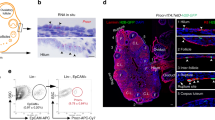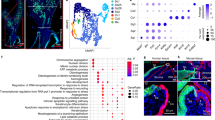Abstract
The purpose of this study was to identify and localize mucosal epithelial progenitor cells (EPCs) in the rat vagina. Rat vagina was obtained from f77emale Sprague-Dawley rats (12 weeks old, n = 20). To identify EPCs in vagina, we followed a single-cell isolation protocol and analyzed the number of cells staining positive for EPC markers by flow cytometry. The expression of EPC-specific markers (CD44, ERα, PR) was evaluated by immunofluorescence. As shown by confocal immunofluorescence, CD44/ERα double-labeled cells were mainly expressed in the basal cell and suprabasal cell layers. Immunofluorescent staining of CD44 was expressed in the plasma membrane of the vaginal epithelium, and ERα was expressed in the cytoplasm of the vaginal epithelium. The CD44/ERα double-positive cells were noted in the rat vagina by flow cytometric analysis. PR-labeled cells were localized in the intermediate layer of the epithelial space of the vagina. The results revealed the existence of EPCs in the vagina. These findings imply that resident EPCs may have a role in the regeneration of vaginal mucosa.
This is a preview of subscription content, access via your institution
Access options
Subscribe to this journal
Receive 8 print issues and online access
$259.00 per year
only $32.38 per issue
Buy this article
- Purchase on Springer Link
- Instant access to full article PDF
Prices may be subject to local taxes which are calculated during checkout


Similar content being viewed by others
References
Goldstein I, Berman JR. Vasculogenic female sexual dysfunction: vaginal engorgement and clitoral erectile insufficiency syndromes. Int J Impot Res. 1998;10(Suppl 2):S84–90. discussionS8-101
Basson R, Brotto LA, Laan E, Redmond G, Utian WH. Assessment and management of women’s sexual dysfunctions: problematic desire and arousal. J Sex Med. 2005;2:291–300.
Kaushic C, Zhou F, Murdin AD, Wira CR. Effects of estradiol and progesterone on susceptibility and early immune responses to Chlamydia trachomatis infection in the female reproductive tract. Infect Immun. 2000;68:4207–16.
Levin RJ. The physiology of sexual function in women. Clin Obstet Gynaecol. 1980;7:213–52.
Lee HS, Kim SO, Ahn K, Park K. All-trans retinoic acid increases aquaporin 3 expression in human vaginal epithelial cells. Sex Med. 2016;4:e249–54.
Park K, Han HJ, Kim SW, Jung SI, Kim SO, Lee HS, et al. Expression of aquaporin water channels in rat vagina: potential role in vaginal lubrication. J Sex Med. 2008;5:77–82.
Blaskewicz CD, Pudney J, Anderson DJ. Structure and function of intercellular junctions in human cervical and vaginal mucosal epithelia. Biol Reprod. 2011;85:97–104.
Wang N, Dong BJ, Quan Y, Chen Q, Chu M, Xu J, et al. Regulation of prostate development and benign prostatic hyperplasia by autocrine cholinergic signaling via maintaining the epithelial progenitor cells in proliferating status. Stem Cell Rep. 2016;6:668–78.
Smirnova NF, Schamberger AC, Nayakanti S, Hatz R, Behr J, Eickelberg O. Detection and quantification of epithelial progenitor cell populations in human healthy and IPF lungs. Respir Res. 2016;17:83.
Gargett CE, Schwab KE, Deane JA. Endometrial stem/progenitor cells: the first 10 years. Hum Reprod Update. 2016;22:137–63.
Patton DL, Thwin SS, Meier A, Hooton TM, Stapleton AE, Eschenbach DA. Epithelial cell layer thickness and immune cell populations in the normal human vagina at different stages of the menstrual cycle. Am J Obstet Gynecol. 2000;183:967–73.
Laumann EO, Paik A, Rosen RC. Sexual dysfunction in the United States: prevalence and predictors. JAMA. 1999;281:537–44.
Simonelli C, Eleuteri S, Petruccelli F, Rossi R. Female sexual pain disorders: dyspareunia and vaginismus. Curr Opin Psychiatry. 2014;27:406–12.
Yong PJ, Willians C, Yosef A, Wong F, Bedaiwy MA, Lisonkova S. et al. Anatomic sites and associated clinical factors for deep dyspareunia. Sex Med. 2017;5:e184–95.
Shabsigh A, Buttyan R, Burchardt T, Buchardt M, Hayek OR, D’Agati V, et al. The microvascular architecture of the rat vagina revealed by image analysis of vascular corrosion casts. Int J Impot Res. 1999;11(Suppl 1):S23–30.
Kim SO, Oh KJ, Lee HS, Ahn K, Kim SW, Park K. Expression of aquaporin water channels in the vagina in premenopausal women. J Sex Med. 2011;8:1925–30.
Wang Y, Sacchetti A, van Dijk MR, van der Zee M, van der Horst PH, Joosten R, et al. Identification of quiescent, stem-like cells in the distal female reproductive tract. PLoS ONE. 2012;7:e40691.
Masuda H, Matsuzaki Y, Hiratsu E, Ono M, Nagashima T, Kajitani T, et al. Stem cell-like properties of the endometrial side population: implication in endometrial regeneration. PLoS ONE. 2010;5:e10387.
Lee JS, Hwang IS, Lee H-S, Kim ME, Seo Y-W, Park K. Identification of endothelial progenitor cells in the corpus cavernosum in rats. Biomed Res Int. 2014;2014:1–5.
Acknowledgements
This research was supported by Basic Science Research Program through the National Research Foundation of Korea (NRF) funded by the Ministry of Education (2015R1D1A1A01059352). We thank Ms. Jennifer Holmes for assistance in editing the text.
Author contributions
Category 1; (a) Conception and Design; KP; (b) Acquisition of Data; H-SL, MEK; (c) Analysis and Interpretation of Data; H-SL, MEK, HSC; Category 2; (a) Drafting the Article; HSC, KP; (b) Revising It for Intellectual Content; KP, JSL, HSC; Category 3; (a) Final Approval of the Completed Article; KP.
Author information
Authors and Affiliations
Corresponding author
Ethics declarations
Conflict of interest
The authors declare that they have no conflict of interest.
Rights and permissions
About this article
Cite this article
Chung, H.S., Lee, HS., Kim, M.E. et al. Identification and localization of epithelial progenitor cells in the vagina. Int J Impot Res 31, 46–49 (2019). https://doi.org/10.1038/s41443-018-0079-6
Received:
Revised:
Accepted:
Published:
Issue Date:
DOI: https://doi.org/10.1038/s41443-018-0079-6



